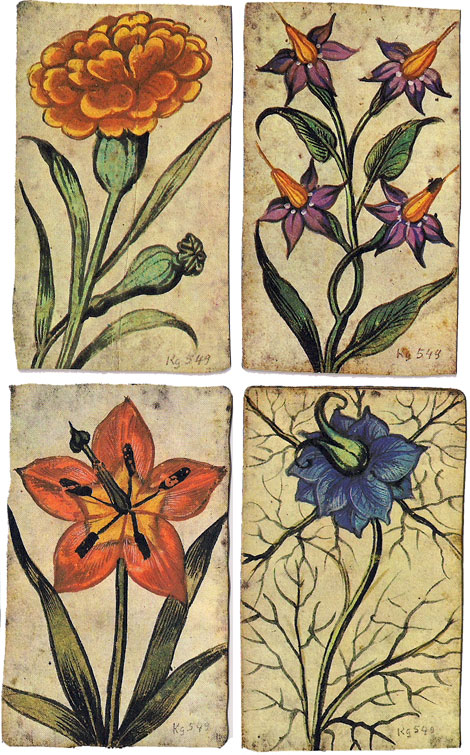Das Kupferstichspiel des I.M.F. von 1617
Playing cards had been made as precious objects for wealthy clients since the late 14th century. They were made to look at, admire and to keep in curiosity cabinets, or perhaps to entertain ladies or educate children rather than to play with.
Engraved Playing Cards, Germany, 1617

by an anonymous artist with the initials I.M.F.
Playing cards had been made as precious objects for wealthy clients since the late 14th century. They were made to look at, admire and to keep in curiosity cabinets, or perhaps to entertain ladies or educate children rather than to play with. These packs often depicted the upper ranks of social hierarchies, as well as trades and vocations, not without parody or satire. Sometimes these miniature art pieces inspired cruder, simpler versions made for play, printed from woodblocks by a commercial artist or woodcutter. Thus their existence had some influence on the everyday, more affordable playing cards which were also being produced.


Above: images from the 1979 Edition Leipzig facsimile that was limited to 999 numbered copies. The facsimile was issued with a 55 page booklet written in German and English. As the booklet points out, this deck, of which there is only one original in existence, was made in the first instance to be a collectable keepsake. This is known from the fact that each card has a different floral back design rendering actual play useless because the value of each card would soon be learned from the particular floral back. There is no attribution to any artist although the engraver, I.M.F is identified on the Nine of Hearts and the name of the publisher, Heinrich Muller, appears on the Four of Hearts. Thanks is given in the booklet to the Staatliche Museen Heidecksburg, Rudolstadt for permission to reproduce in facsimile the original cards in their possession.
Expensive playing cards, gold edged and printed from copper plates, were available for those who could afford them. The demand for these copper-plate engraved cards must have been great because a fair number of examples have survived from the fifteenth and sixteenth centuries, usually preserved in curiosity cabinets. Although they were rather exclusive items, often they highlight artistic trends, styles and influences from other places, and were also inspiration to commercial workshops where cheaper cards were being produced. Thus it could be argued that the elite were able to influence the lower classes through their expensive playing cards! However, the argument can also be turned the other way, since some examples of fifteenth century woodcut cards can be seen to have influenced copper-plate engraved cards.
In the example we have here, the four Kings are mounted on thrones whilst the Upper and Lower Valets are standing, their suit signs being respectively high or low. The numeral cards have the suit signs at the top, embellished with ornamental scrolls, and small illustrations or vignettes at the bottom. These are all of interest on account of their artistic freedom and were, of course, the standard format for German-suited cards in those days.
However, perhaps the most striking aspect are the watercolour floral paintings on the reverse, which are botanically accurate representations and thus of educational value. It is not known whether they are by the same artist who painted the cards; possibly by someone who practised miniature painting.
• See the box►
REFERENCES
Fournier Museum, Playing Cards, Germanic countries no. 14
Hoffmann, Detlef: The Playing Card, an illustrated history, Edition Leipzig, 1973
Images of the facsimile edition from the collection of Rod Starling, author of "The Art and Pleasures of Playing Cards".

By Rod Starling (1936-2023)
Member since January 09, 2013
Rod Starling was one of the founding members of the 52 Plus Joker card collectors club. He authored many articles for the club's quarterly newsletter, Clear the Decks. His collection encompasses both foreign and American decks. Rod also authored a book titled The Art and Pleasures of Playing Cards.
Related Articles

CARD-AB Miltenberg
Illustrations by Rita Stern depicting notable landmarks and scenes from the town of Miltenberg in Ge...

New Altenburg Skat cards – German DDR Pattern
Authentic Altenburger Skat cards with German suits (Acorns, Hearts, Leaves, Bells).

German Travel Cards
A travel-themed educational deck helping American tourists visiting Germany.

French Revolutionary cards by Pinaut
Seven cards from a French Revolutionary pack by Pinaut featuring characters from classical antiquity...

Songs with Flute accompaniment
Eighteenth century English engraved cards with music for voice and flute.

Briefmarken-Quartett
Quartet game featuring postage stamps from the Zones of Occupation in post-WWII Germany.

IG Chemie Papier Keramik
Promotional pack designed by Karl-Heinz Schroers for a German trade union with comical bears on the ...

Engel-Tarot
Set of major arcana designed by Alois Hanslian depicting angels throughout.

Virgil Solis
Remarkable pack of 52 animal-suited playing-cards designed and etched by Virgil Solis.

Dr Sacheverell
Dr. Henry Sacheverell's impeachment in 1710 sparked widespread public unrest and political upheaval,...

Politiker-Skat by Bubec
Caricatures of world leaders, including many German politicians, by the artist Bubec.

Le Poker Politique
French politicians and various world leaders caricatured by the German artist Bubec.

Rouen Pattern - Portrait Rouennais
An attractive XV century French-suited design from Rouen became the standard English & Anglo-America...

Johann Nejedly Tarok Cards
Johann Nejedly, a 19th-century Viennese card maker, produced Tarock cards featuring modern scenes th...

Hand-drawn set of 52 playing cards
An imaginatively hand-drawn set of 52 playing cards by an amateur artist, 18th century.

Unimog UX 100
Cartoons promoting the Unimog UX 100, a small truck produced by Mercedes-Benz.
Most Popular
Our top articles from the past 28 days

